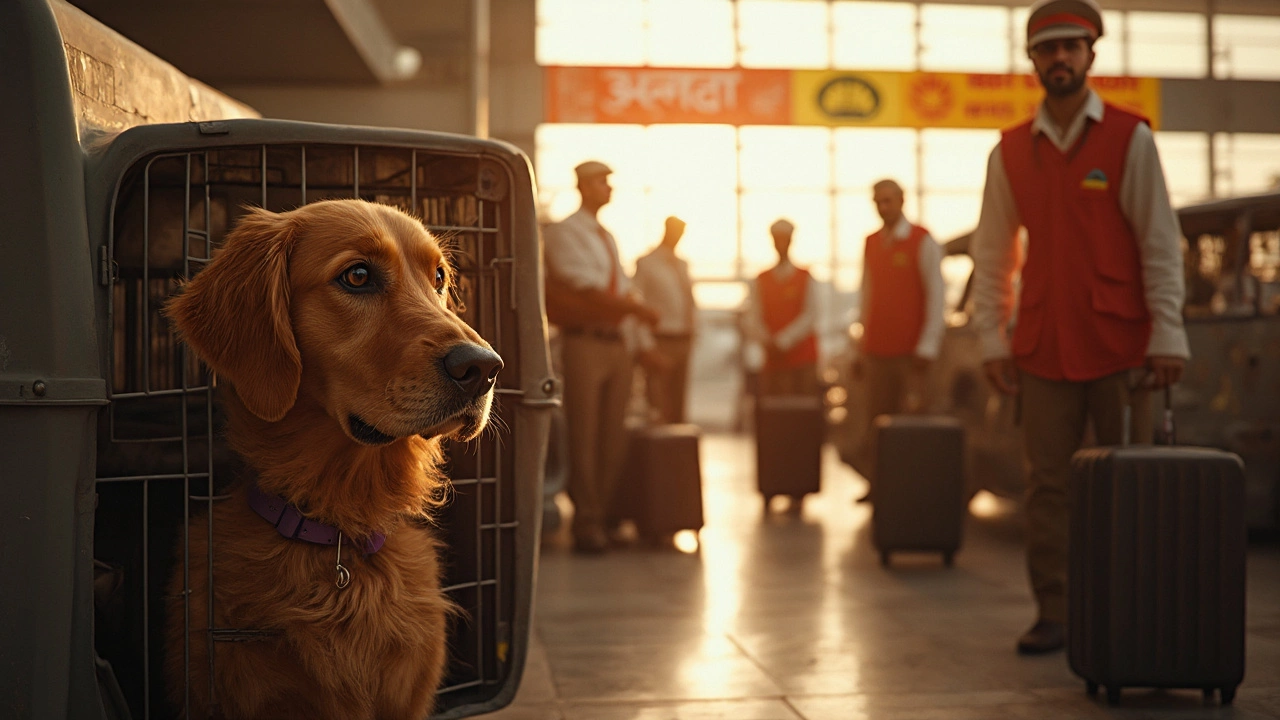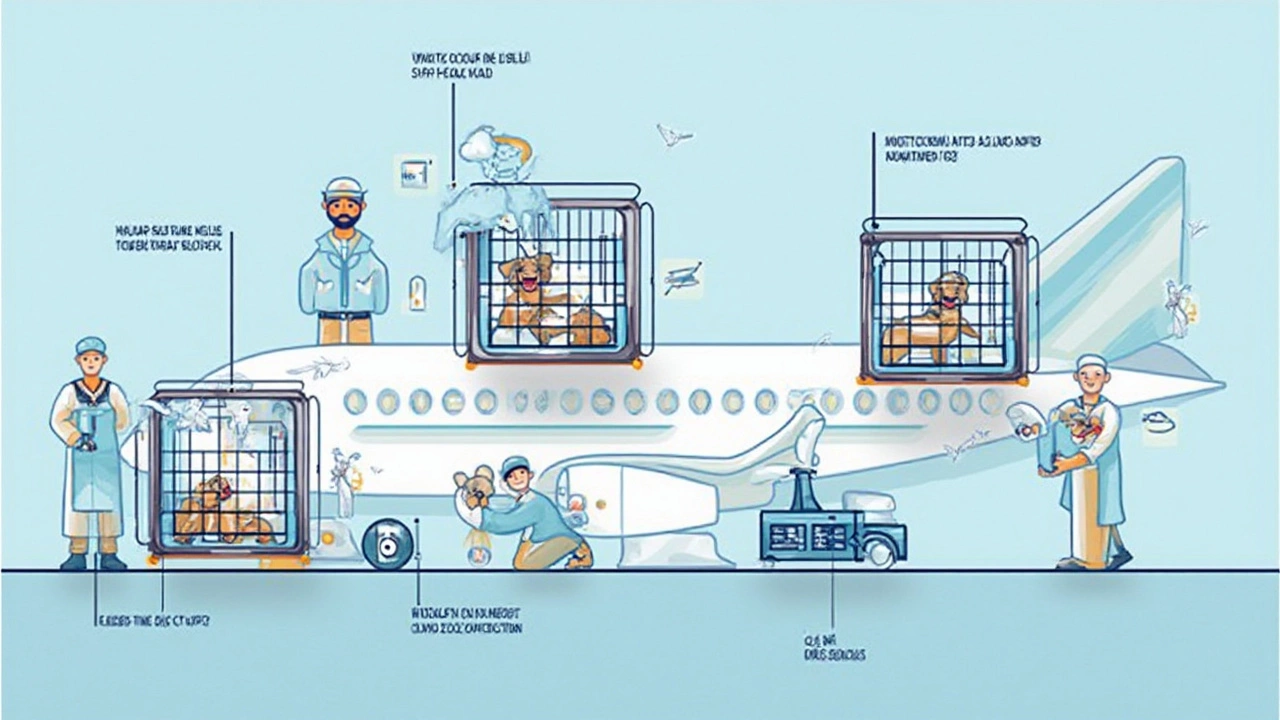
You want to take your dog on a trip, but cargo holds a reputation that’s a little scary. Some people swear their dogs flew without a hitch, while others have horror stories. The truth is, flying in cargo isn’t a one-size-fits-all solution—some dogs handle it better than others, and some flights are just riskier.
Before you book anything, you need the real details: what’s actually happening in that cargo hold, what the biggest risks look like, and which dogs are more likely to get into trouble. Airlines have strict rules and even more restrictions, but surprises happen. Knowing what can go wrong—and what works—is the first step to keeping your dog safe and calm.
Don’t worry, we’re about to break it down. You’ll get practical advice, not just bland warnings. Because let’s be honest: leaving your dog’s safety to chance isn’t something most pet owners are willing to risk.
- The Facts: How Safe is Cargo for Dogs?
- Common Risks and Real-Life Incidents
- What Airlines Actually Do for Pet Safety
- Tips to Make Flying Safer for Your Dog
- Who Should Avoid Cargo (and What to Do Instead)
The Facts: How Safe is Cargo for Dogs?
This part isn’t sugar-coated—dogs fly in cargo every single day, but the level of risk depends on a bunch of factors nobody should ignore. Airlines in the U.S. are required to report any incidents involving pets, so we actually have some solid data to go on.
Take a look at this quick breakdown of government-reported pet incidents from U.S. airlines (latest numbers from 2023):
| Year | Dogs Carried | Injuries | Deaths | Lost |
|---|---|---|---|---|
| 2023 | ~211,000 | 6 | 8 | 0 |
| 2022 | ~198,000 | 9 | 11 | 1 |
So, the death or injury rate is low—less than 0.01%—but that doesn’t tell the whole story. Not every airline flies pets, and not every incident actually makes it into these reports. Still, most dogs make it through a dog cargo safety flight just fine, especially on major airlines with good reputations.
What really matters is your dog’s health, age, breed, stress level, and even the time of year you’re flying. Heat and cold can be a serious problem for dogs in cargo, and snub-nosed breeds (like Bulldogs or Pugs) are at way higher risk for breathing problems. There are also airline rules that block these breeds from cargo flights for exactly this reason.
Some airlines, like Delta and United, publish their own stats and safety guarantees, but there’s no such thing as 100% safe. You also won’t find a uniform standard for equipment, temperature, or how long a dog might be sitting on the tarmac.
- If a dog is healthy, not a snub-nosed breed, and travels during milder weather, the odds are in your favor.
- International flights are usually more regulated and have better animal handling protocols.
- Economy airlines or smaller carriers are more hit-and-miss with pet care and staff training.
Bottom line: Cargo is never totally risk-free, but with the right preparation and picking the right airline, it can be a safe option for many dogs. Knowing the facts beats guesswork every time.
Common Risks and Real-Life Incidents
Putting your dog in an airplane’s cargo hold isn’t without risks. Not all flights go wrong, but when things do happen, they can be serious. The most common problems reported include extreme temperatures, rough handling, lost pets, and even mix-ups where pets end up far away from their families.
Let’s start with temperature. Cargo areas aren’t always as climate-controlled as you’d hope, especially while the plane waits on the tarmac. There have been stories in the news about pets suffering from heatstroke or hypothermia. Bulldogs and other short-nosed breeds are at much higher risk—Delta Airlines stopped allowing them in cargo back in 2016 after several tragic incidents.
- Dog cargo safety comes down to monitoring and quick reactions, but that's not guaranteed.
- Some airlines have accidentally sent dogs to the wrong city. In 2018, a United Airlines dog ended up in Japan instead of Kansas.
- Rough baggage handling or kennel damage can cause injuries to pets. Sometimes crates break apart, and dogs escape into busy airports—the stuff of nightmares.
Sheena Ramsey, a veterinarian with experience overseeing pet cargo transport, put it bluntly:
“While most animal flights go off without incident, the risks—heat, stress, escape—are real and often underreported. Owners need to consider if their dog could handle a worst-case scenario.”
If you want hard numbers, here are some recent U.S. Department of Transportation stats for pet incidents on planes in 2023:
| Year | Pets Flown in Cargo | Incident Reports | Deaths | Injuries | Lost Pets |
|---|---|---|---|---|---|
| 2023 | 155,000 | 21 | 7 | 12 | 2 |
That might sound rare, but to someone whose pet is that "one in a thousand," it’s everything. Stories of near-misses pop up every year online, from cracked kennel doors to dogs handed off to the wrong person. Airlines will emphasize improvements, but every number in a government report is a real family’s painful story. Not trying to scare you—just laying out the facts so you can make the best call for your dog.

What Airlines Actually Do for Pet Safety
Airlines know people worry about putting their dogs in cargo, so they've set up a bunch of rules and checks. Not all airlines do things exactly the same way, but most of the big ones in the US, Canada, and Europe follow pretty strict safety routines. It basically comes down to temperature control, secure kennels, careful handling, and clear rules about which dogs can fly and when.
- Dog cargo safety means temperature is kept between 45°F and 85°F on most major airlines. If it’s hotter or colder, they just won’t let pets board.
- They keep the cargo hold pressurized, same as the main cabin. Your dog won’t be gasping for air or freezing.
- Dogs are loaded last and unloaded first to limit the time spent waiting on the tarmac, where temperatures or noise can get bad fast.
- Most airlines restrict flights for certain breeds (like Frenchies or bulldogs) because they’re more likely to have breathing problems during flight.
- Air Canada, Delta, and United all have specific staff trained just for handling pets. That doesn’t mean your dog gets royal treatment—but it’s better than random baggage handlers doing the job.
For some hard numbers, take a look at this recent stat table. The US Department of Transportation keeps tabs on incidents involving animals on planes every year. Here’s what the last complete year looked like:
| Airline | Pets Boarded | Incidents Reported* |
|---|---|---|
| Delta | 13,205 | 2 |
| United | 11,084 | 4 |
| American | 7,002 | 1 |
*Incidents means death, injury, or loss—dog, cat, or other pet.
That’s less than 1 in 3,000 cases with a problem, but the numbers don’t include unreported issues, stress, or minor injuries. Airlines are also getting stricter each year, so some routes (especially in summer and winter) might suddenly refuse pet bookings, even if you’ve flown with them before. Always double-check right before you travel.
Airlines also won’t let dogs fly in cargo on connecting flights where layovers put your pet at risk for sitting too long on a hot or cold tarmac. Direct flights only for most pups now.
The big takeaway: airlines put real effort into pet safety—but nothing’s foolproof. The rules are in place, staff are trained, and stats look decent, but it’s still a stressful, loud, and sometimes unpredictable place for a dog.
Tips to Make Flying Safer for Your Dog
Flying your dog in cargo isn’t always risky, but there’s plenty you can do to tip the scales in your favor. Let’s keep it simple and real—because you want your dog to land safe, not stressed or sick.
Here are the must-follow steps for safer travel:
- Pick non-stop flights. Every transfer just means extra time in handling, a higher chance for delays, and more moving around that your dog really doesn’t need.
- Avoid extreme weather. Airlines will say they control the climate, but studies show tarmac temps get hot fast. Early morning or late evening flights in summer, midday flights in winter—timing matters.
- Invest in a solid, airline-approved crate. It should be big enough for your dog to stand, turn, and lie down, with vented sides and no way to slip out. Label it with your contact info and “Live Animal” tags where nobody can miss them.
- Skip feeding your dog 4-6 hours before departure. Less food means less chance for air sickness or accidents. Make sure they’re hydrated, but don’t overdo it.
- Add a familiar-smelling blanket or toy. Quick tip: an old t-shirt of yours can help them chill out when they’re alone down there.
- Visit the vet. Most airlines need a health certificate, but honestly, this step matters for more than paperwork. Some breeds—like bulldogs and pugs—face serious breathing trouble in cargo and, in many cases, are banned for a reason.
A peek at some real numbers shows what you’re up against:
| Year | Dogs Transported (U.S. Major Airlines) | Incidents (Injury, Loss, Death) |
|---|---|---|
| 2019 | 404,556 | 34 |
| 2022 | 293,149 | 13 |
Sure, it looks like a tiny percentage. But if your dog is the ‘one,’ the stat is cold comfort. Prep matters if you want good odds. Airlines will point you to their dog cargo safety guarantees, but always read the fine print—some only offer refunds, not real help, for lost or hurt pets.
If you’re worried, check if your airline has an extra pet program that lets you track your dog’s crate or get text updates. Delta and Alaska Airlines have some handy services, though nothing is perfect yet.

Who Should Avoid Cargo (and What to Do Instead)
Not every dog is a good match for flying in the cargo hold. Some face way more risks than others, and ignoring these could end up being a nightmare for both you and your pet. If your dog fits into any of the following categories, steer clear of cargo travel and look at better options.
- Brachycephalic Breeds: Dogs with short noses, like bulldogs, pugs, and boxers, are at the top of the no-fly-in-cargo list. They struggle with temperature shifts and low oxygen, putting them at serious risk of breathing trouble—or worse.
- Puppies and Seniors: Puppies under 8 weeks and older dogs don’t handle stress and changes in pressure well. Their immune systems are weaker, and they’re more prone to dehydration and shock.
- Dogs with Medical Conditions: Heart problems, anxiety, or respiratory issues make cargo a bad idea. A flight can make these issues way worse when nobody’s around to help.
- Pregnant Dogs: Airlines generally refuse to fly pregnant pets, and with good reason—it’s risky for both the mom and the pups.
- Extremely Large or Small Dogs: Big dogs sometimes need custom crates, which can hike up risks since loading and handling get more complicated. The tiniest dogs chill much faster and might get too cold down there.
Data from the U.S. Department of Transportation backs this up. Here’s a quick look at reported animal incidents during air travel in the U.S. in 2023:
| Animal Type | Breed Risk Factors | Number of Incidents* |
|---|---|---|
| Dogs (all breeds) | Brachycephalic, elderly, very young | 34 |
| Cats | Brachycephalic breeds | 8 |
*Incidents include deaths, injuries, and losses as reported by airlines.
So, what should you do instead of putting your dog in cargo?
- Check if your airline allows pets in the cabin. Most small dogs (under 20 lbs with carrier) can fly in-cabin under the seat in front of you.
- Think about driving, especially for trips under 12 hours. It’s less stressful, and you’re with your pet the entire time.
- Trusted pet moving services exist for cross-country or international moves. These experts handle weird paperwork and specialty care for pets who just shouldn’t fly with everyone else.
- If you really must fly, talk to your vet—get their ok and see if any medications or precautions can help.
For some dogs, skipping cargo isn’t just safer—it’s the only choice. The risk just isn’t worth it for these pups. The safest bet? Keep your dog cargo safety worries at bay by picking better travel options when your dog’s health is on the line.




